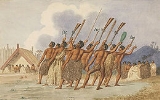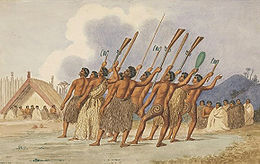
Haka
Encyclopedia

Dance
Dance is an art form that generally refers to movement of the body, usually rhythmic and to music, used as a form of expression, social interaction or presented in a spiritual or performance setting....
or challenge from the Māori people of New Zealand
New Zealand
New Zealand is an island country in the south-western Pacific Ocean comprising two main landmasses and numerous smaller islands. The country is situated some east of Australia across the Tasman Sea, and roughly south of the Pacific island nations of New Caledonia, Fiji, and Tonga...
. It is a posture dance performed by a group, with vigorous movements and stamping of the feet with rhythmically shouted accompaniment. The New Zealand rugby team's practice of performing a haka before their matches has made the dance more widely known around the world.
History
Although the use of haka by the All BlacksHaka of the All Blacks
The Haka is a traditional Maori war dance from New Zealand. There are thousands of Haka that are performed by various tribes and cultural groups throughout New Zealand. The best known Haka of them all is called "Ka Mate". It has been performed by countless New Zealand teams both locally and...
rugby union team and the Kiwis
New Zealand national rugby league team
The New Zealand national rugby league team has represented New Zealand in rugby league football since intercontinental competition began for the sport in 1907. Administered by the New Zealand Rugby League, they are commonly known as the Kiwis, after the native bird of that name...
rugby league team has made one type of haka familiar, it has led to misconceptions. Haka are not exclusively war dances or performed only by men. Some are performed by women, others by mixed groups, and some simple haka are performed by children. Haka are performed for various reasons: for amusement, as a hearty welcome to distinguished guests, or to acknowledge great achievements or occasions (McLean 1996:46–47).
War haka (peruperu) were originally performed by warriors before a battle, proclaiming their strength and prowess in order to intimidate the opposition. Today, haka constitute an integral part of formal or official welcome ceremonies for distinguished visitors or foreign dignitaries, serving to impart a sense of the importance of the occasion.
Various actions are employed in the course of a performance, including facial contortions such as showing the whites of the eyes and the poking out of the tongue, and a wide variety of vigorous body actions such as slapping the hands against the body and stamping of the feet. As well as chant
Chant
Chant is the rhythmic speaking or singing of words or sounds, often primarily on one or two pitches called reciting tones. Chants may range from a simple melody involving a limited set of notes to highly complex musical structures Chant (from French chanter) is the rhythmic speaking or singing...
ed words, a variety of cries and grunts are used. Haka may be understood as a kind of symphony in which the different parts of the body represent many instruments. The hands, arms, legs, feet, voice, eyes, tongue and the body as a whole combine to express courage, annoyance, joy or other feelings relevant to the purpose of the occasion.
Types
The various types of haka include whakatu waewae, tutu ngarahu and peruperu. The peruperu is characterised by leaps during which the legs are pressed under the body. In former times, the peruperu was performed before a battleBattle
Generally, a battle is a conceptual component in the hierarchy of combat in warfare between two or more armed forces, or combatants. In a battle, each combatant will seek to defeat the others, with defeat determined by the conditions of a military campaign...
in order to invoke the god of war and to discourage and frighten the enemy. It involved fierce facial expressions and grimaces, poking out of the tongue, eye bulging, grunts and cries, and the waving of weapons. If the haka was not performed in total unison, this was regarded as a bad omen for the battle. Often, warriors went naked into battle, apart from a plaited flax belt around the waist. The aim of the warriors was to kill all the members of the enemy war party, so that no survivors would remain to undertake revenge.
The tutu ngarahu also involves jumping, but from side to side, while in the whakatu waewae no jumping occurs. Another kind of haka performed without weapons is the ngeri, the purpose of which was to motivate the warriors psychologically. The movements are very free, and each performer is expected to be expressive of their feelings. Manawa wera haka were generally associated with funerals or other occasions involving death. Like the ngeri they were performed without weapons, and there was little or no choreographed movement.
The most well-known haka is "Ka Mate
Ka Mate
"Ka Mate" is a Māori haka composed by Te Rauparaha, war leader of the Ngāti Toa tribe of the North Island of New Zealand.-The creation and composition of Ka Mate:...
", attributed to Te Rauparaha
Te Rauparaha
Te Rauparaha was a Māori rangatira and war leader of the Ngāti Toa tribe who took a leading part in the Musket Wars. He was influential in the original sale of conquered Rangitane land to the New Zealand Company and was a participant in the Wairau Incident in Marlborough...
, war leader of the Ngāti Toa
Ngati Toa
Ngāti Toa , an iwi , traces its descent from the eponymous ancestor Toarangatira. The Ngāti Toa region extends from Miria-te-kakara at Rangitikei to Wellington, and across Cook Strait to Wairau and Nelson....
tribe. The "Ka Mate" haka is classified as a haka taparahi – a ceremonial haka. "Ka Mate" is about the cunning ruse Te Rauparaha used to outwit his enemies, and may be interpreted as "a celebration of the triumph of life over death" (Pōmare 2006).
Gender of participants
Most haka are performed by men, with the female role, if any, limited to providing support by singing in the background. There are however some haka which are performed predominantly by women – one of the most well-known being the Ngāti PorouNgati Porou
Ngāti Porou is a Māori iwi traditionally located in the East Cape and Gisborne regions of the North Island of New Zealand. Ngāti Porou has the second-largest affiliation of any iwi in New Zealand, with 71,910 registered members in 2006...
haka "Ka Panapana"
Mythology
According to Māori mythologyMaori mythology
Māori mythology and Māori traditions are the two major categories into which the legends of the Māori of New Zealand may usefully be divided...
, the sun god, Tama-nui-te-rā
Tama-nui-te-ra
In Māori mythology, Tama-nui-te-rā is the personification of the Sun.Māui decided that the days were too short and caught Tamanui-te-rā with a snare, then beat him to make him travel more slowly across the sky. In some legends Tama-nui-te-rā is the husband of Ārohirohi, goddess of mirages...
, had two wives, the Summer Maid, Hine-raumati, and the Winter Maid, Hine-takurua. Haka originated in the coming of Hine-raumati, whose presence on still, hot days was revealed in a quivering appearance in the air. This was the haka of Tāne-rore
Tane-rore
In Maori mythology, Tane-Rore is the personification of shimmering air as deity Tanerore performs a haka for his mother Hine Ruamati.Tama-nui-te-ra had two wives, Winter maid Hine-takurua and the Summer maid Hine-raumati...
, the son of Hine-raumati and Tama-nui-te-rā.
See also
- Haka of the All BlacksHaka of the All BlacksThe Haka is a traditional Maori war dance from New Zealand. There are thousands of Haka that are performed by various tribes and cultural groups throughout New Zealand. The best known Haka of them all is called "Ka Mate". It has been performed by countless New Zealand teams both locally and...
- Haka in popular cultureHaka in popular cultureThe haka is a traditional Māori dance form. The use of haka in popular culture is a growing phenomenon, originally from New Zealand. Traditionally, haka were used only in Māori cultural contexts, but today haka are used in a wide range of public occasions to impart a sense of importance of the...
- Kapa hakaKapa hakaThe term Kapa haka is commonly known in Aotearoa as 'Maori Performing Arts' or the 'cultural dance' of Maori people...
- KailaoKailaoThe Kailao is a Wallisian war dance imported to Tonga from nearby 'Uvea .-History:It is usually performed at public and private ceremonies. The men, bearing stylized clubs , dance in a fierce manner that emulates fighting, all to the accompaniment of a beaten slit drum or a tin box, which sets the...
- Māori musicMaori musicTe Pūoro Māori or Māori Music is music composed or performed by Māori, the native people of New Zealand, and includes a wide variety of folk music styles, often integrated with poetry and dance, as well as modern rock and roll, soul, reggae and hip hop....
- Siva tauSiva tauThe Manu Siva Tau is a Samoan war dance, performed by the Samoa's sporting teams before each match.The national rugby union team used to perform the traditional 'Ma'ulu'ulu Moa' on tour...
- CibiCibiThe Cibi is a Fijian meke of Bauan origin and is a war dance, generally performed before battle or after battle, it came to prominence when it was performed by the Fiji national rugby union team before each match.-Origins:...
- HulaHulaHula is a dance form accompanied by chant or song . It was developed in the Hawaiian Islands by the Polynesians who originally settled there. The hula dramatizes or portrays the words of the oli or mele in a visual dance form....
- Battle tranceBattle tranceBattle trance is a term denoting a specific altered state of consciousness that characterizes the psychological state of combatants during a combat situation. In this state, combatants do not feel fear or pain , and all the individual members of group are acting as one collective organism...
- Battle cryBattle cryA battle cry is a yell or chant taken up in battle, usually by members of the same military unit.Battle cries are not necessarily articulate, although they often aim to invoke patriotic or religious sentiment....
- Military music
External links
- Haka – A New Zealand icon
- Photo of Maori BattalionMaori BattalionThe 28th Battalion, more commonly known as the Māori Battalion, was an infantry battalion of the New Zealand Army that served during the Second World War. It was formed following pressure on the Labour government by some Māori MPs and Māori organisations throughout the country wanting a full Māori...
soldiers performing a haka in Egypt during the Second World War - A haka performed by women, supported by men singing in the background
- A haka performed by children (Te Kapa Haka o Manawa Tapu)
- Impressions of a national kapa haka contest
- Haka in An Encyclopaedia of New Zealand, edited by A. H. McLintock, originally published in 1966.

